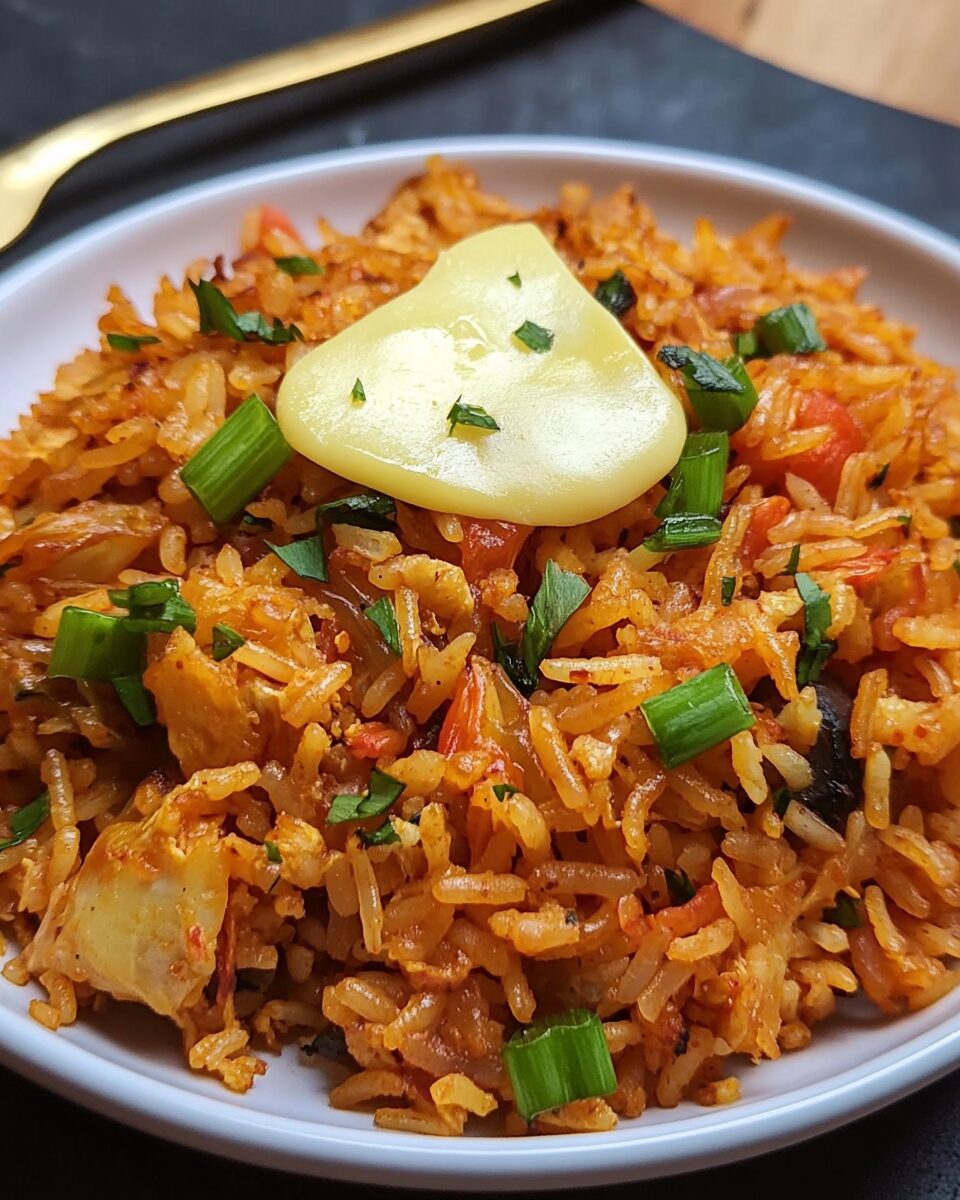Kimchi Fried Rice, known as “Kimchi Bokkeumbap” in Korean, is a flavorful and spicy dish that combines stir-fried rice with kimchi and other ingredients. It’s a popular way to use leftover rice and kimchi, resulting in a quick and satisfying meal.
FULL RECIPE:
Ingredients
- 2 cups cooked white rice, preferably chilled
- 1 cup chopped kimchi
- 2 tablespoons kimchi juice
- 1 tablespoon gochujang (Korean red pepper paste)
- 1 tablespoon soy sauce
- 1 tablespoon vegetable oil
- 2 teaspoons sesame oil
- 2 green onions, chopped
- 2 cloves garlic, minced
- 2 large eggs
- Salt and pepper to taste
- Sesame seeds for garnish
Directions
- Heat vegetable oil in a large skillet or wok over medium-high heat. Add minced garlic and cook until fragrant, about 30 seconds.
- Add chopped kimchi to the skillet and stir-fry for 2-3 minutes until heated through.
- Stir in the cooked rice, breaking up any clumps, and cook for another 2-3 minutes.
- In a small bowl, mix together kimchi juice, gochujang, and soy sauce. Pour this mixture over the rice and kimchi, stirring well to combine. Cook for an additional 2 minutes.
- Push the rice mixture to one side of the skillet. Crack the eggs into the empty side and scramble them until fully cooked.
- Combine the scrambled eggs with the rice mixture. Drizzle sesame oil over the top and mix well. Season with salt and pepper to taste.
- Remove from heat and garnish with chopped green onions and sesame seeds before serving.
Nutrition Facts
- Calories: 305
- Total Fat: 17g
- Saturated Fat: 7.3g
- Trans Fat: 0.5g
- Polyunsaturated Fat: 3.1g
- Monounsaturated Fat: 4.8g
- Cholesterol: 135mg
- Sodium: 708mg
- Total Carbohydrates: 28g
- Dietary Fiber: 1.8g
- Sugars: 1.5g
- Protein: 11g
- Vitamin D: 0.7mcg
- Calcium: 50mg
- Iron: 1.1mg
- Potassium: 505mg
The History and Cultural Significance of Kimchi Fried Rice
Kimchi has been a fundamental part of Korean cuisine for centuries, dating back to ancient times when fermentation was used to preserve vegetables for long winters. The practice of fermenting cabbage with chili powder, garlic, and other spices has been an essential part of Korean culinary heritage. Over time, kimchi became a versatile ingredient, incorporated into various dishes beyond its traditional form as a side dish. Fried rice, on the other hand, is a dish that has roots in many Asian cultures, most notably in China. As Korean cuisine evolved, it was natural for kimchi and fried rice to come together, resulting in the creation of kimchi fried rice.
Why Kimchi Fried Rice Is So Popular
One of the reasons kimchi fried rice is so well-loved is its perfect balance of flavors. The fermented kimchi provides a tangy, slightly sour, and spicy kick, while the addition of ingredients like soy sauce, sesame oil, and gochujang (Korean red pepper paste) enhances its umami depth. The dish is also highly customizable, allowing people to adjust the spice level and add proteins such as fried eggs, pork belly, tofu, or even seafood. Another reason for its popularity is its simplicity and convenience. Unlike many traditional Korean dishes that require extensive preparation, kimchi fried rice can be made in just a few minutes using basic ingredients. Since it primarily consists of cooked rice and kimchi, it is an excellent way to reduce food waste and repurpose leftovers into a delicious meal.
Variations of Kimchi Fried Rice
Kimchi fried rice is incredibly versatile, and different regions and households in Korea have their own unique ways of preparing it. Some variations focus on additional ingredients to enhance the dish, while others emphasize different cooking techniques. One popular variation is Cheese Kimchi Fried Rice, where a generous amount of melted cheese is added on top. The creamy and rich cheese balances the spiciness of the kimchi, making it a comforting dish loved by many. Another common version is Pork Belly Kimchi Fried Rice, which incorporates Samgyeopsal (Korean pork belly) into the dish. The rendered fat from the pork adds an extra layer of savory flavor, making it a favorite choice for meat lovers.
The Role of Gochujang in Kimchi Fried Rice
While kimchi itself adds a lot of flavor, many recipes also include gochujang, a Korean red pepper paste made from fermented soybeans, red chili powder, and rice. This ingredient deepens the spiciness and umami taste of the dish, giving it an extra kick. Gochujang is one of the most essential condiments in Korean cooking, and it pairs exceptionally well with the tangy and bold flavors of kimchi. Those who prefer a milder taste may reduce the amount of gochujang or omit it entirely, depending on their spice tolerance.
The Importance of Using Leftover Rice
One of the key tips for making the best kimchi fried rice is using leftover, chilled rice rather than freshly cooked rice. Fresh rice tends to be too moist and sticky, which can lead to a mushy texture when stir-fried. In contrast, day-old rice has a firmer texture, allowing it to absorb the seasonings better and develop that signature slightly crispy exterior when stir-fried in a hot pan. If you only have fresh rice, a simple trick is to spread it out on a plate and let it cool in the refrigerator for about 30 minutes before cooking. This helps dry out excess moisture and improves the final texture of the dish.
How to Serve Kimchi Fried Rice
Kimchi fried rice is commonly served with a fried egg on top, which adds a creamy and rich element to the dish. The runny yolk enhances the flavor and balances the spiciness of the kimchi. A sprinkle of sesame seeds and chopped green onions is often added for garnish, providing extra texture and visual appeal. For an authentic Korean experience, kimchi fried rice is best enjoyed with additional side dishes (banchan) such as pickled radish, stir-fried vegetables, or a bowl of warm soup. Pairing it with a cool drink like barley tea or a glass of soju can also elevate the dining experience.
Health Benefits of Kimchi Fried Rice
While kimchi fried rice is considered comfort food, it also offers several health benefits, primarily due to its main ingredient, kimchi. Kimchi is a probiotic-rich food, thanks to its fermentation process, which promotes good gut health by introducing beneficial bacteria into the digestive system. Probiotics have been linked to improved digestion, a stronger immune system, and better overall health. For those looking for a more nutritious version of kimchi fried rice, substituting white rice with brown rice or quinoa can provide extra fiber and essential nutrients. Adding lean protein sources such as tofu, chicken, or shrimp can further enhance its nutritional profile.
Conclusion
Kimchi fried rice is a timeless dish that embodies the essence of Korean comfort food. Its bold flavors, simplicity, and versatility make it a favorite among people worldwide. Whether you enjoy it as a quick meal at home, a late-night snack, or a way to use up leftovers, kimchi fried rice never fails to satisfy. From its humble origins as a way to repurpose aged kimchi to its widespread popularity in Korean restaurants and home kitchens, kimchi fried rice continues to be a staple dish that brings people together. With countless variations and endless ways to customize it, this dish proves that sometimes, the simplest recipes are the most delicious.






